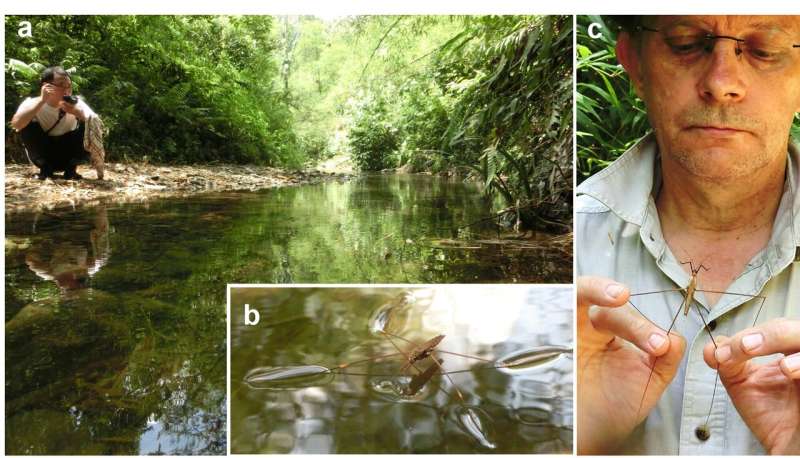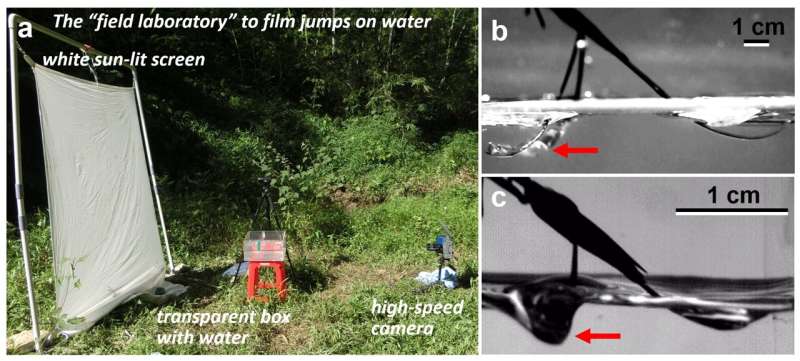This article has been reviewed according to Science X's editorial process and policies. Editors have highlighted the following attributes while ensuring the content's credibility:
fact-checked
peer-reviewed publication
proofread
Examining how the world's largest water striders jump on water

Water striders live on the water surface and their leg length ranges from several to over 100 millimeters. It is well known that they use their long hydrophobic legs and support their bodies on the surface without breaking it. Under each leg, the water surface bends down creating a dimple (meniscus). Heavier water striders create deeper dimples, which produce stronger upward force from the downward stretched water surface that supports the insect body.
When water striders escape from predators attacking from under the water, they jump upward. Their jump can reach a speed above 1 m/s within just a fraction of a second (10–20 milliseconds) without breaking the water surface, and robots have been produced that imitate this behavior.
To produce those jumps, water striders move their legs fast downwards against the water surface but not too fast so that the water surface remains unbroken. In this case, each dimple works like a mini trampoline: the deeper it is pressed the stronger is the upward force making the fast jump possible.
Until recently it was thought that all water striders jump in this way. However, only several small species representing just 10% of the full range of water striders' body sizes (10–60 mg) have been studied because they are easily available to researchers.
Recent research expeditions to study the world's largest water striders in the subtropical forests of Vietnam, followed by mathematical modeling, have discovered a new mechanism of jumping used by the giant water strider (Gigantometra gigas) and some other large water striders exceeding the body size of about 80 mg.
The recently published research was carried out by a team of biologists and engineers from Seoul National University (Korea), Museum and Institute of Zoology at Polish Academy of Sciences (Poland), Daegu Gyeongbuk Institute of Science & Technology (Korea), Vietnam Academy of Science and Technology (Vietnam), and Vietnam National University (Vietnam), and École Polytechnique (France).
The study has revealed a new jumping mechanism employed by the giant water striders, which are ten times heavier than the more commonly studied. Field research on this species was conducted in Pu Mat National Park, Vietnam with the help from the Pu Mat National Park administration during two field expeditions. The researchers filmed high-speed videos of the giant water striders jumping in their natural habitats and in transparent water containers situated near the stream where the water striders live.
The team observed a crucial difference in the jumping behavior between these giant water striders and the typical smaller species that have already been studied. Unlike smaller water striders, the giant water striders actually break the water surface when their legs push downward during a jump. After their legs penetrate the water surface, the legs quickly move downward surrounded by a layer of air caught within and around long hairs present on the legs of this species.
When a leg surrounded by the air moves through the water it experiences a resistive force, called drag, opposing its motion. This is similar to the manner in which an oar is used to propel a boat on the water. This force pushes the giant water striders upward during the second phase of a jump. Within a fraction of a second (about 40 milliseconds), the giant water striders achieve the body speed of about 1m/s or more. Even though they employ a novel jumping mechanism, such speed is comparable to that of the previously studied smaller species.

The team then developed a mathematical model of jumping by water striders to uncover the reason behind this unique jumping behavior exhibited by the giant water striders. The researchers discovered that these world's largest water striders are so heavy that the same mechanism of not breaking the water surface would simply not work; it would result in slower jump that would make them vulnerable to the predators such like fish.
However, by moving their legs fast enough to break the water surface and to produce the drag in the water, the insects are able to jump sufficiently fast to escape predatory attacks. The model predicts that water striders heavier than about 80 mg should use this method of jumping to reach the speed that can protect them from fish's attack. This illustrates the important role of natural selection in the evolution of the new jumping mechanism in large water striders.
This discovery demonstrates that water striders employ different jumping mechanisms based on their body size. "We have unveiled a novel jumping mechanism used by giant water striders. This finding demonstrates that closely related species can utilize different physical mechanisms depending on their size, despite performing the same behavior (jumping) for the same function (escaping from predators)," comments the research team.
"This discovery is interesting from both engineering and evolutionary viewpoints because it provides inspiration for water walking robots and establishes solid theoretical grounds for future comparative analyses across multiple species of water striders to understand coevolution between body size and jumping mechanism in water striders"—a project that the research team is undertaking now.
The work is published in the journal Proceedings of the National Academy of Sciences.
More information: Woojoo Kim et al, Two different jumping mechanisms of water striders are determined by body size, Proceedings of the National Academy of Sciences (2023). DOI: 10.1073/pnas.2219972120
Journal information: Proceedings of the National Academy of Sciences
Provided by Laboratory of Behavioral Ecology and Evolution at Seoul National University




















